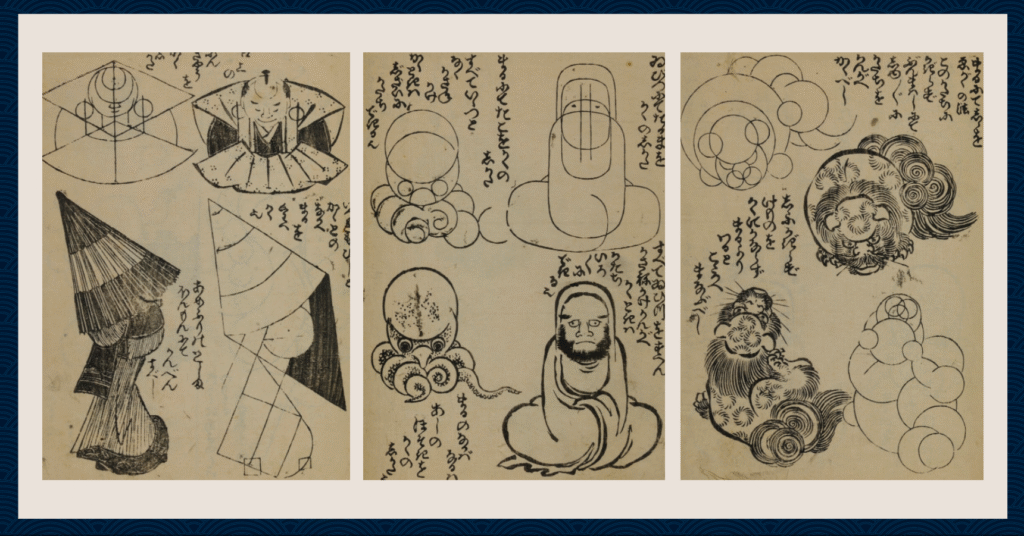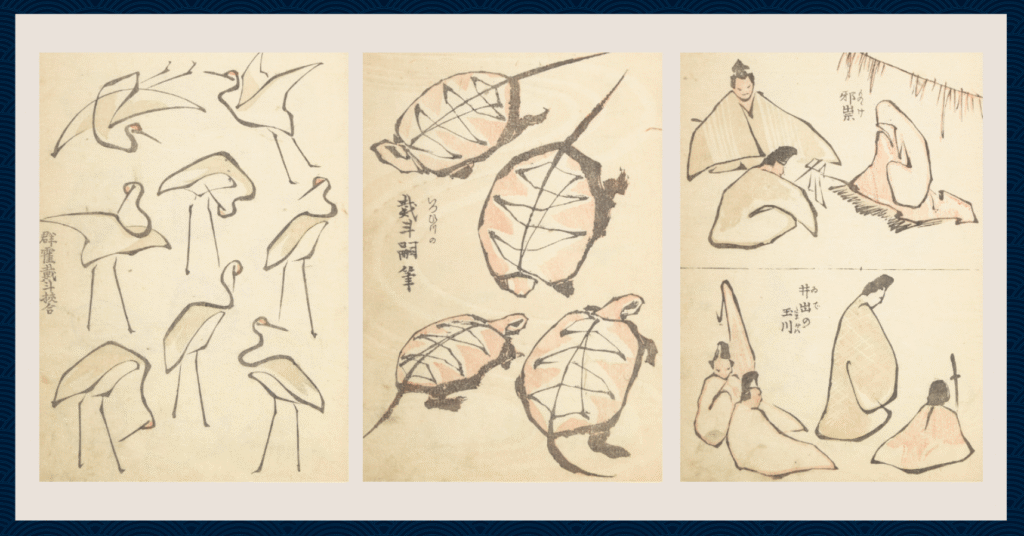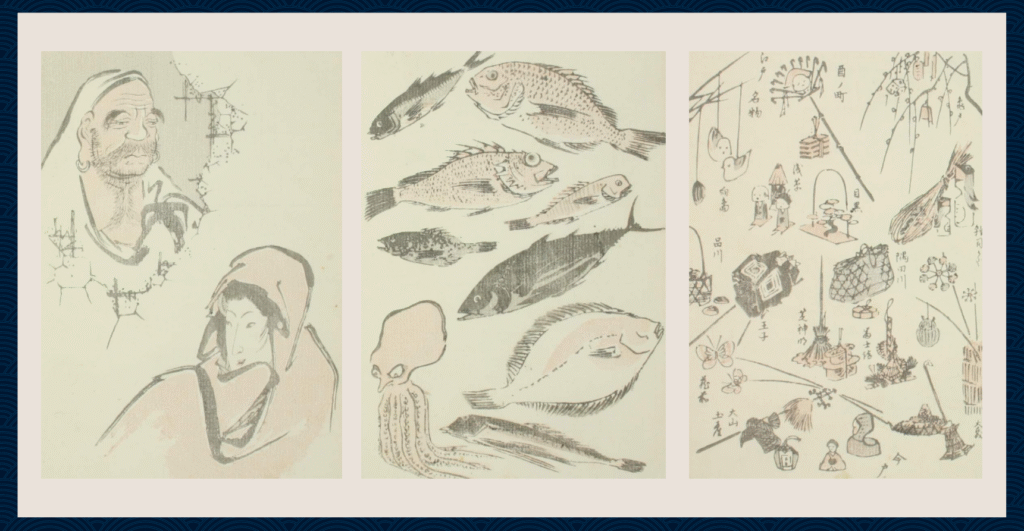The artistic treasures left by master painters from Japan’s Edo period (1603-1868) represent some of the most celebrated works in art history. While many people are familiar with the vibrant multi-colored woodblock prints and meticulously detailed hand-painted ukiyo-e, there’s a lesser-known aspect of these artists’ work that deserves attention—their sketches. This article introduces you to the captivating world of cute ukiyo-e sketches and where you can freely access these digital archives.
The Sketch Culture of Edo Japan and Its Modern Appeal
When thinking about ukiyo-e, most people imagine Hiroshige’s “Fifty-three Stations of the Tōkaidō” or Hokusai’s “Thirty-six Views of Mount Fuji.” However, Edo-period artists also created numerous “gafu” (picture albums) and “ryakuga” (simplified drawings) that functioned similar to modern sketchbooks.
These works provide valuable insights into the creative processes of master artists while possessing an approachability that resonates with contemporary sensibilities. The simplified lines, exaggerated expressions, and charming representations in these cute ukiyo-e sketches established aesthetic principles that continue to influence Japanese visual culture today, including manga, anime, and modern design.
For Western audiences unfamiliar with these terms, “ukiyo-e” (literally “pictures of the floating world”) refers to Japanese woodblock prints and paintings that flourished during the Edo period. They typically depicted scenes from everyday life, landscapes, historical events, and entertainment districts.
Cute Ukiyo-e Sketches from the Edo Period
Hokusai’s “Ryakuga Hayashinan” — A Master’s Teaching Manual
Katsushika Hokusai (1760-1849), perhaps the most internationally recognized ukiyo-e artist, published numerous instructional manuals throughout his career. “Ryakuga Hayashinan” (Quick Guide to Simplified Drawing) consists of two volumes and, as the title suggests, serves as what we might call a “quick sketching tutorial” in contemporary terms.
Hokusai, who changed his name and artistic style more than 30 times during his 82-year life, reveals his educational side in this work. His technique of capturing the essence of subjects with quick, efficient lines offers valuable lessons for modern designers and illustrators.
“Ryakuga” refers to a simplified drawing style where the artist uses minimal lines to express the fundamental characteristics of the subject. These cute ukiyo-e sketches demonstrate how Japanese artists could convey emotion and movement with remarkable economy.

Hokusai’s “Denshin Kaishu: Ippitsu Gafu” — Conveying Spirit with a Single Stroke
The title “Denshin Kaishu” carries the meaning “techniques to convey the divine essence of subjects.” This collection showcases methods for drawing samurai, children, turtles, birds, cats, mice, and other subjects using a single continuous stroke.
“Ippitsu-ga” (one-stroke drawings) became popular in Edo Japan after being introduced from China. However, Hokusai elevated this practice beyond mere entertainment, positioning it as training to instantly capture a subject’s essence. His ability to express the movements and characteristics of familiar animals like cats and mice with a single line creates cute ukiyo-e sketches that feel surprisingly modern and accessible.
For Western audiences, these cute ukiyo-e sketches might evoke comparisons to Picasso’s famous single-line drawings, though they precede the Spanish master by more than a century.

Hiroshige’s “Ukiyo Gafu” — The Landscape Master’s Animal Sketches
Utagawa Hiroshige (1797-1858), renowned for his landscape prints, shows a different side of his artistry in “Ukiyo Gafu,” which features numerous animal and figure sketches. The cat drawings are particularly noteworthy, capturing various feline poses and playful behaviors with remarkable accuracy.
Hiroshige’s cat illustrations could be considered forerunners to today’s popular cat content on social media, demonstrating how the universal appeal of these animals transcends time and culture. The collection also includes collaborative volumes with fellow artist Keisai Eisen, providing insight into how Edo-period artists worked together.
The term “gafu” refers to picture albums or collections of sketches and illustrations that were often used as references by other artists or for educational purposes.

Isshunsai/Kisshun’s “Shoshoku Jinbutsu Gafu” — An Encyclopedia of Edo Commoner Life
“Shoshoku Jinbutsu Gafu” (Picture Album of Various Occupations and People) documents the diverse occupations and daily lives of ordinary people during the Edo period. The sketches depict carpenters, papermakers, candy sellers, and many other tradespeople, offering a vivid record of commoner culture during this era.
The preface states: “The painter Master Sesshu said that painting possesses noble qualities. Inheriting the foundation laid by renowned painters, we have compiled this volume gathering illustrations of people, plants, flowers, and birds, exhaustively depicting various occupations and people in the ‘Shoshoku Jinbutsu Gafu.'”
When viewed through a contemporary lens, these cute ukiyo-e sketches capture essential characteristics of their subjects with charming simplicity, potentially serving as precursors to modern “kawaii” (cute) illustration styles.

Modern Applications for Ukiyo-e Sketches
These cute ukiyo-e sketches from the Edo period offer more than just historical documentation—they provide inspiration for contemporary creators. For example:
- Design Resources: The technique of capturing essential features with minimal lines, as seen in these cute ukiyo-e sketches, can be applied to logo design and character creation.
- Illustration Inspiration: Modern illustrators and manga artists can find fresh inspiration in the Edo-period representations of people and animals.
- Cultural Gateway: For international designers, these sketches offer insight into the historical roots of Japanese “kawaii” aesthetics.
Japanese Aesthetic Principles Evident in Ukiyo-e Sketches
The cute ukiyo-e sketches of the Edo period reflect several distinctive Japanese aesthetic principles:
- The Beauty of Omission: Expressing subjects’ essence using minimal necessary lines
- Utilization of Negative Space: Engaging viewers’ imagination by what remains undrawn
- Focus on the Ordinary: Finding beauty in everyday life rather than the extraordinary
- Playfulness: Maintaining humor and whimsy even within serious artistic traditions
These characteristics continue to influence contemporary Japanese pop culture and design, forming the historical foundation for the concept of “kawaii” or cuteness that has become a globally recognized aspect of Japanese culture.
Conclusion: The Timeless Appeal of Cute Ukiyo-e Sketches
The sketches left by Edo-period artists offer a different kind of charm compared to their finished woodblock prints. Viewed through contemporary eyes, these simplified expressions and lively depictions contain numerous elements that modern viewers find endearingly “cute.”
We hope that through the free digital archives introduced in this article, you’ll discover the appeal of these cute ukiyo-e sketches and gain a deeper appreciation for the richness of Japanese visual culture. Stay tuned for our second installment, where we’ll introduce even more sketch works by various Edo-period masters.
*Note: The contents of the digital archives mentioned in this article may change without notice due to policy changes at each institution. Please check each institution’s official website for the most current information.*
Explore More Free Downloadable Resources
If you’re interested in discovering more freely downloadable historical Japanese art resources for your creative projects, click the banner below. Our curated collection includes additional ukiyo-e prints, kimono pattern books, and rare illustrated manuscripts that offer authentic glimpses into Japan’s artistic heritage. Continue your journey through the floating world and beyond with these carefully selected visual treasures from Japan’s golden age of woodblock printing.



